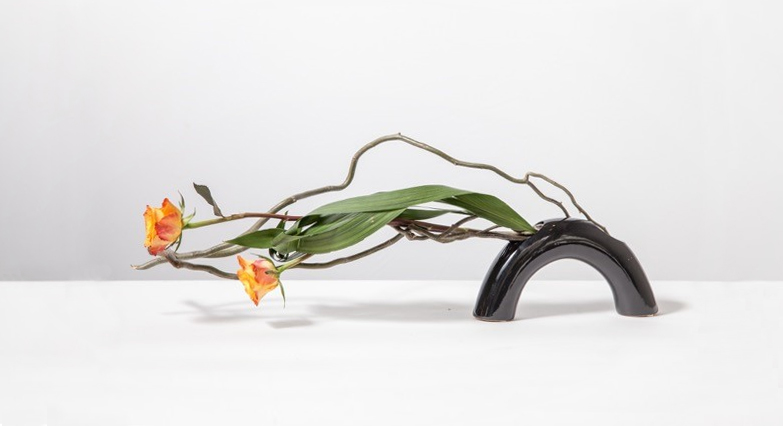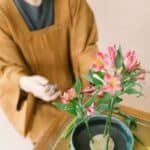
Introduction
Japanese Ikebana art, also known as Kadō, is a traditional form of floral arrangement that has been practiced for centuries in Japan. It is a highly regarded art form that emphasizes the beauty of nature and the harmony between flowers, branches, and leaves.

Ikebana is not simply arranging flowers in a vase, but rather a disciplined practice that requires careful consideration of space, balance, and form. With its deep cultural and spiritual significance, has become an integral part of Japanese aesthetics and continues to be practiced and appreciated worldwide.
The History and Origins of Ikebana
Harmony in Blooms: Discover the Artistry of Japanese Ikebana
Ikebana, the traditional Japanese art of flower arrangement, has a rich history that dates back centuries. This art form, which emphasizes simplicity, balance, and harmony, has its roots in ancient Buddhist rituals and has evolved over time to become a highly respected and cherished cultural practice in Japan. To truly appreciate the beauty and significance of art, it is important to delve into its history and origins.
One cannot discuss the history without acknowledging its close association with Buddhism. In the 6th century, Buddhism was introduced to Japan from China and Korea, bringing with it various religious rituals and practices. One such practice was the offering of flowers to the Buddha as a form of devotion. This act of offering flowers gradually evolved into a more refined art form, known as Ikebana.
Initially, the art was practiced exclusively by Buddhist priests and was primarily focused on creating arrangements for religious ceremonies. These early arrangements were characterized by their simplicity and minimalism, reflecting the Zen Buddhist philosophy of finding beauty in simplicity. The arrangements were often asymmetrical, with a few carefully selected flowers or branches arranged in a way that conveyed a sense of tranquility and harmony.
Over time, Ikebana began to gain popularity among the general population in Japan. As the art form spread, different schools emerged, each with its own unique style and techniques. One of the most influential schools was the Ikenobo school, which was founded in the 15th century and is still active today. The Ikenobo school introduced new principles and techniques that further refined the art.

While Ikebana remained deeply rooted in its Buddhist origins, it also began to incorporate elements of Shintoism, the indigenous religion of Japan. Shintoism places great importance on the natural world and the spirits that reside within it. As a result, started to incorporate natural materials such as branches, leaves, and even rocks into its arrangements, further emphasizing the connection between nature and spirituality.
In the 19th century, Japan opened its doors to the world and experienced a period of rapid modernization. This had a profound impact on the art. As Japan embraced Western influences, started to incorporate new materials and techniques, blending traditional Japanese aesthetics with Western floral design principles. This fusion of styles gave rise to a new form known as Moribana, which featured arrangements in shallow containers and allowed for more freedom in composition.


Today, continues to evolve and adapt to the changing times. While traditional styles such as Rikka and Shoka are still practiced, contemporary artists are pushing the boundaries of the art form, experimenting with new materials, shapes, and concepts. Despite these changes, the core principles of Ikebana remain unchanged – simplicity, balance, and harmony.
In conclusion, the history and origins are deeply intertwined with Buddhism and the cultural traditions of Japan. From its humble beginnings as a religious offering, Ikebana has evolved into a highly respected art form that continues to captivate and inspire people around the world. Whether one appreciates the traditional styles or embraces the contemporary interpretations, testament to the enduring beauty and significance of Japanese culture.






Conclusion
In conclusion, Japanese art is a traditional form of floral arrangement that emphasizes simplicity, asymmetry, and the use of natural materials. It is deeply rooted in Japanese culture and aesthetics, reflecting the harmony between humans and nature. Is not just about arranging flowers, but also about expressing emotions, capturing the essence of seasons, and creating a sense of tranquility and mindfulness. It has evolved over centuries and continues to be practiced and appreciated as a unique art form worldwide.
What is Ikebana?
Ikebana is the Japanese art of flower arrangement, characterized by its focus on harmony, balance, and simplicity. It is more than simply putting flowers in a container; it is a disciplined art form in which nature and humanity are brought together.
What are the Origins of Ikebana?
As its roots in ancient Japan, with its origins traced back to Buddhist rituals and practices of flower offerings at altars. Over time, it evolved into a highly refined art form influenced by various cultural and aesthetic principles.
What are the Key Principles of Ikebana?
The key principles of Ikebana include minimalism, asymmetry, balance, harmony, and respect for the natural beauty and symbolism of flowers and branches. It emphasizes the use of space and silence to create a sense of tranquility and mindfulness.
What Materials are Used in Ikebana?
In Ikebana, a wide variety of natural materials can be used, including flowers, branches, leaves, grasses, and even fruits or vegetables. Each element is carefully selected and arranged to express a specific theme, mood, or season.
What are the Different Styles of Ikebana?
There are numerous styles and schools of Ikebana, each with its own techniques, aesthetics, and philosophical approaches. Some of the most well-known schools include Ikenobo, Sogetsu, and Ohara, each offering unique interpretations of the art form.
How is Ikebana Taught and Practiced?
Ikebana is traditionally taught through apprenticeship or in specialized schools known as ikebana-ryū (ikebana schools). Students learn various techniques, principles, and styles under the guidance of experienced instructors through hands-on practice and observation.
What are the Benefits of Practicing Ikebana?
Practicing Ikebana offers a range of benefits, including promoting mindfulness, creativity, and appreciation for nature. It can also serve as a form of relaxation, stress relief, and self-expression, fostering a deeper connection with oneself and the natural world.

[…] evolved and diversified over the years. This introduction aims to provide a brief overview of the cultural significance and development of graffiti in […]